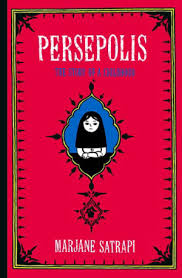 I know that most of you will know this as the film, but true to my pseudo-intellectual bourgeois-ness, I will tell you that it was a book first. A graphic novel, actually, written by Marjane Satrapi.
I know that most of you will know this as the film, but true to my pseudo-intellectual bourgeois-ness, I will tell you that it was a book first. A graphic novel, actually, written by Marjane Satrapi.
At the outset, I want to say two things: first, that in the light of the recent awareness of feminism that has happened on our campus (unless it’s just wishful thinking on my part) I wanted to do my two bits, so I’m writing this review of a book that to me was stridently and proudly feminist in its origins and ideas. Second, I want to write this review without giving away anything in the book, so I may be a little sparse in my description.
This book begins in 1980 in Iran. The historically inclined amongst us will know that it is in these years that the Iranian Revolution happened. The Shah was thrown over, and a so-called Republic was established under the leadership of Ayatollah Khomeini, and protected by the Guardians of the Islamic Jurists.
Marjane is a 10 year old in Tehran when our story begins, the child of two radical Marxists, she grows up with an unusual outlook to the Revolution going on around her: she’s young enough to have that childlike belief that we lose somewhere in our journey to adulthood and has a healthy critical attitude bred by the fact that her parents encouraged her to think about everything she sees, and say what she thinks.
Her journey is immensely interesting – it’s a horribly adult world seen through the lenses of a child. She lives through the execution of Revolutionaries – including her friends and family, she lives through her formerly French school being converted into an Islamic school that lies to its children. We watch events unfold before her that we already knew had happened, but they achieve a very different sort of significance when we see them the way a child would.peddle fundamentalism to her. We watch her journey as she grows up in Iran during the revolution, and where she goes after that: we follow her from the age of 10 to her mid-twenties; we learn, as she does, of what it’s like to be a thinking individual in a world where you are expected only to follow.
There’s enough in this book to appeal to everyone – I liked Marjane for her combination of faith and cynicism. It’s something we all go through when we look at governance. I’m sure that a political lesson is waiting for us in the book, in the midst of our elections, the Iranian Republic shows us the price we pay for an intolerant State – lives are lost, lives are ruined – the political system becomes less than a farce when people’s voices raised in dissent are silenced brutally.
There’s something to be said about the role of religion in a State which forces it down the throat of its people. The book shows us how individual liberties are curtailed, how religious edicts are used as weapons of oppression. The status of women in this state is even worse – they are considered worthless in themselves; their value comes only from their chastity and what they offer to a man.
And then the book is over, and you look at your life and society around you, and you are shocked by how little is different in the book from outside it. We still see women being subjugated by society, we still see women being valued only in their relationship with men: wives, mothers, sisters, daughters. Admittedly, the atrocities are far less, because the State is secular, it is governed by the objectivity of law, but the social attitudes towards women are not so different.
So read the book, it makes you think. It makes you understand another culture, another time. It makes you part of a larger reality than your immediate conscious. And if you’re lucky, it makes you care.

2 responses to “Persepolis: A Book Review”
Excellent review! I think the sentence “we learn, as she does, of what it’s like to be a thinking individual in a world where you are expected only to follow” sums it up perfectly. I agree that it’s scary to think about how women are objectified and oppressed the world over — not just in Iran, but also in Scotland, as you’ve pointed out, and also in the United States.
LikeLike
Whoops! I apologize. I am a new visitor to your site and I assumed that “Glasnost” was a play on the word “Glasgow,” Scotland’s largest city (a weird thing to assume, I admit). After a quick glance at your “About” page, I can see that I was very mistaken…
LikeLike